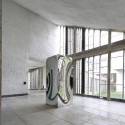
Nothing FAIRER, for a Biennial entitled Modern Life, than paying a tribute to the Swiss architect naturalized French, Le Corbusier (1887 – 1965) in the year of his 50th death anniversary.
Le Corbusier is commonly referred to as the father of modern architecture, as he proposed five principles of architecture that reformed the basis of the architectural language – for example, the deployment of stilts that lift buildings off the ground and the open floor plan concept, large internal spaces that are set free from traditional structural concepts.
Le Corbusier’s five points of a new architecture are present in the Convent of La Tourette, one of Le Corbusier’s most impressively beautiful constructions, commissioned by the Dominican Order and inaugurated in 1960 near the city of Lyon.
Designed to accommodate up to 100 monks, the monastery comprises two large main blocks: the convent area, with classrooms, dormitories and a chapel. The area of the chapel is the same as the area of the dorms, as if every inhabitant of the monastery had their own individual space in the church.
The convent is now inhabited by less than ten monks and in 2009, it implemented a contemporary art program to welcome and host art works that dialogue with Le Corbusier’s historic building.
“The works interact with the multiple shapes of the building’s architecture, either through the mirror, or through the dialogue established between the materials and textures of the walls of concrete and wax, or, in other words, through the resonance created between the radiating light beams and the circular sculptures”, said Friar Marc Chauveau, inhabitant of the monastery and curator of the exhibition.
The result is, indeed, stunning, to use a term that is usually avoided in newspaper articles. But, in this particular case, “stunning” does no justice to the sensation created by the Le Corbusier-Kappor collaboration. The construction is undoubtedly a masterpiece. Its chapel, in particular, lets in colourful light rays – an effect created by the application of basic colours on the window bars, without the use of stained glass.
Secondly, Kapoor’s art is strongly influenced by spiritual concepts, and it matches the atmosphere of the space perfectly and respectfully. If modern life is collapsing, as suggested by the Lyon Biennial, Le Corbusier still stands as one of its most solid, unshakeable pillars.
Anish Kapoor chez Le Corbusier
Through January 3
Couvent de la Tourette
Route de La Tourette, 69210 – Éveux/França
couventdelatourette.fr

Deixe um comentário